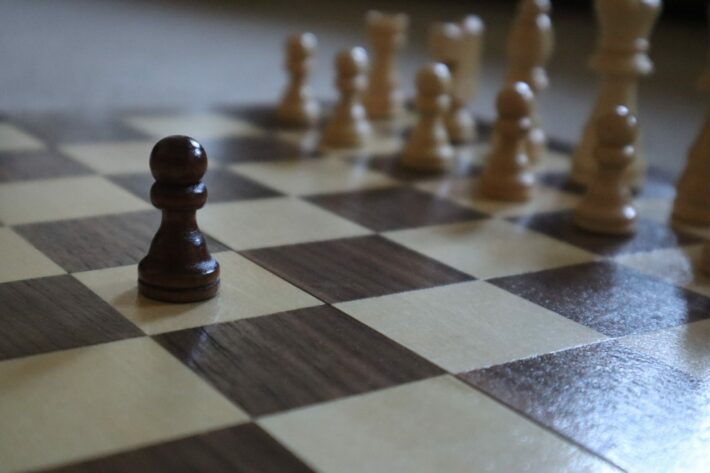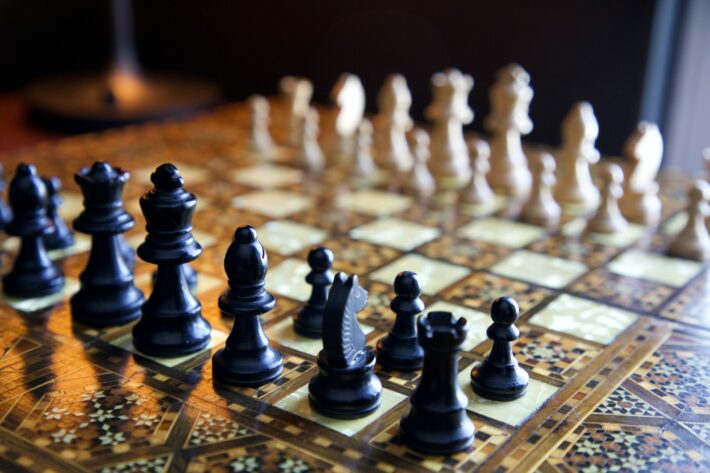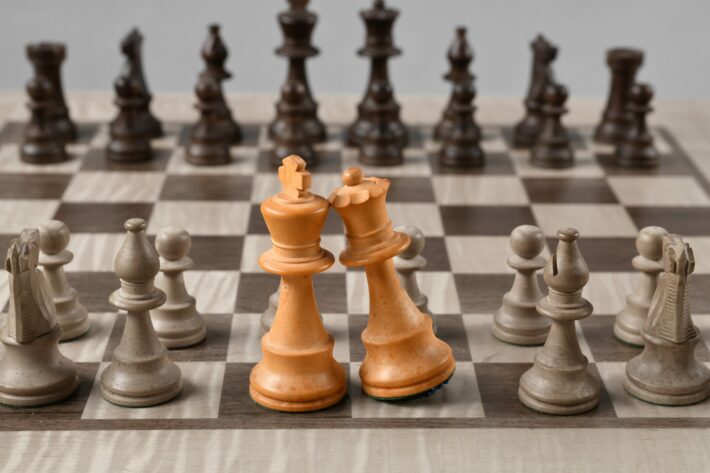Setting up your chess board correctly is the foundation for a successful game. Whether you’re a beginner or a seasoned player, understanding the step-by-step process is essential. In this comprehensive guide, we will walk you through the intricacies of assembling your chess board with precision and finesse.
From the strategic placement of the rooks to positioning the knights just so, we leave no detail untouched to ensure your chessboard is ready for the ultimate battle. Get ready to immerse yourself in the captivating world of chess and become a master of board setup. Let’s embark on this journey together!
What are the essential steps for setting up a chessboard?
Setting up a chessboard involves several crucial steps. First, place the board correctly with a light square on the right. Next, position the rooks on the corners, followed by the knights beside them. Then, arrange the bishops next to the knights.
The queen should occupy the square matching her color, and the king is placed beside her. Finally, position the pawns in a row in front of the other pieces. Following these steps precisely ensures a properly set-up chess board, creating a solid foundation for an engaging and strategic game of chess.
How do I arrange the chess pieces on the board correctly?

Arranging the chess pieces correctly is vital for a fair and balanced game. Start by placing the rooks on the corners of the board. Then, position the knights next to the rooks. After that, place the bishops next to the knights.
The queen should occupy the square of her color, and the king is placed beside her. Finally, arrange the pawns in a row in front of the other pieces. By following this arrangement, you’ll ensure a proper setup that allows for strategic gameplay and an enjoyable chess experience.
What is the proper positioning of the rooks on a chessboard?
The rooks, also known as castles, have a specific position on the chessboard. They are placed on the corners, occupying the squares a1 and h1 for the white rooks and a8 and h8 for the black rooks.
Placing the rooks in these positions allows for their optimal movement and potential involvement in castling, a key defensive and strategic maneuver in chess. Properly positioning the rooks ensures they are ready to contribute to your game plan and adds to the overall balance and aesthetics of the chessboard.
Where should the knights be placed when setting up a chessboard?
When setting up a chess board, the knights have specific placements. They are positioned beside the rooks, occupying the squares b1 and g1 for the white knights and b8 and g8 for the black knights.
Placing the knights in these positions allows for their unique L-shaped movement, enabling strategic maneuvers and potential attacks. By correctly positioning the knights, you set the stage for their involvement in various tactical combinations and contribute to the overall balance and dynamics of the chessboard.
What is the correct order for arranging the chess pieces during setup?
The correct order for arranging the chess pieces during setup is as follows: first, place the rooks on the corners of the board. Next, position the knights beside the rooks. Then, place the bishops next to the knights.
Following this, the queen occupies the square matching her color, and the king is positioned beside her. Finally, arrange the pawns in a row in front of the other pieces. Adhering to this specific order ensures a systematic and organized setup, allowing for strategic gameplay and maintaining the integrity of the chessboard.
Are there any specific rules for setting up a chessboard?
Yes, there are specific rules to follow when setting up a chessboard. These rules include ensuring that the board is positioned correctly with a light square on the right. The rooks occupy the corners, the knights are placed beside the rooks, and the bishops are positioned next to the knights.
The queen and king are placed on their respective squares, and the pawns are arranged in a row in front of the other pieces. Adhering to these rules guarantees a standard setup, facilitating fair play and consistency in chess games.
How can I ensure that my chessboard is set up accurately?
To ensure an accurate chessboard set up, attention to detail is crucial. Double-check that the board is positioned correctly, with a light square in the right corner. Verify that the rooks are correctly placed in the corners, followed by the knights, then the bishops.
Confirm that the queen occupies the square matching her color, with the king beside her. Finally, ensure the pawns are arranged in a row in front of the other pieces. By carefully following these steps and reviewing the setup, you can be confident that your chess board is accurately arranged, setting the stage for a fair and enjoyable game.
The table provides valuable guidelines and insights to ensure an accurate chessboard setup.
| Aspect | Guidelines | Importance |
|---|---|---|
| Orientation | Ensure the board has a light square on the right side. | Proper orientation maintains consistency and fairness in gameplay. |
| Rook Placement | Position the rooks on the corners of the board. | The correct placement allows for potential rook maneuvers and castling. |
| Knight Positioning | Place the knights beside the rooks. | Proper positioning maximizes their unique L-shaped movement capabilities. |
| Bishop Arrangement | Position the bishops next to the knights. | Strategic placement offers enhanced control of diagonals and potential attacking opportunities. |
| King and Queen | Ensure the queen occupies the square matching her color, with the king placed beside her. | Correct placement sets the stage for various opening strategies and potential casting. |
What is the significance of properly setting up the chess pieces?

Properly setting up the chess pieces holds significant importance in the game of chess. A correct arrangement ensures fair play, consistency, and balanced gameplay. Each piece has a specific role and movement pattern, and their initial placement affects strategic possibilities.
By adhering to the proper setup, players can start the game on equal footing, with opportunities to plan and execute tactics effectively. Additionally, a well-arranged chessboard adds aesthetic appeal, creating a visually pleasing environment for players and spectators alike. Overall, a proper chess piece setup sets the stage for engaging and competitive gameplay.
Can improper chessboard setup affect the gameplay?
Yes, improper chessboard setup can significantly impact gameplay. Incorrect piece placements may result in an unfair advantage for one player, leading to imbalanced gameplay. It can affect the accessibility and effectiveness of certain strategic moves or hinder the flow of the game.
Moreover, an improperly set up board may cause confusion, mistakes, or misunderstandings during play, disrupting the overall experience. To ensure a fair and enjoyable game, it is essential to adhere to the proper chess board setup guidelines and verify the correct placement of each piece before starting the game.
Are there any tips or tricks for setting up a chessboard efficiently?
Certainly! When setting up a chess board efficiently, consider using mnemonic devices to remember the correct piece placements. For example, the phrase “Queens Don’t Move Kings Sideways” can help you remember that the queen always starts on her color square.
Additionally, organizing the pieces by color or type before placing them on the board can streamline the process. Taking a moment to familiarize yourself with the setup guidelines and practicing the arrangement can also speed up the process. By incorporating these tips and tricks, you can set up your chess board efficiently and be ready to start the game in no time.
What is the purpose of placing the king and queen in specific positions?
The specific positions of the king and queen on a chessboard have strategic significance. The queen is placed on the square matching her color (e.g., d1 for white or d8 for black), emphasizing her central and dominant role in the game. The king is positioned beside the queen.
Placing the king in a relatively protected position, albeit not fully shielded, reflects the importance of safeguarding the monarch throughout the game. The positioning of the king and queen sets the stage for potential casting maneuvers and influences the development of various opening strategies and midgame plans.
How does the placement of the bishops affect the game of chess?
The placement of the bishops plays a vital role in the game of chess. Each player starts with two bishops, one on a light square and the other on a dark square. This positioning allows the bishops to cover different squares on the chessboard, offering diverse attacking and defensive possibilities.
Placing the bishops near the center or on open diagonals enhances their scope and potential influence on the game. Skillful utilization of the bishops can lead to powerful attacks, control of key areas, and the creation of tactical opportunities, making their placement a crucial consideration in chess strategy.
Are there any variations in setting up a chessboard for different game modes?
While the standard setup is used in traditional chess, there are variations in setting up a chessboard for different game modes. Chess variants, such as Chess960 or Fischer Random Chess, introduce randomized starting positions for the pieces, creating unique gameplay experiences.
Other variants, like Three-Check Chess or King of the Hill Chess, have specific win conditions or modified rules that may impact piece placement. It is essential to consult the rules of the specific game variant being played to determine any deviations from the standard setup and adapt the board arrangement accordingly.
What are the consequences of incorrectly arranging the chess pieces?
Incorrectly arranging the chess pieces can lead to various consequences in gameplay. It may result in an unfair advantage for one player, skewing the balance of power. Certain strategic moves or openings may become unavailable or ineffective due to the improper positioning of key pieces.
Additionally, mistakes in piece placement can lead to confusion, disputes, or disruptions during play, affecting the overall experience. To avoid these consequences, it is crucial to take the time to set up the chess pieces correctly, ensuring a fair and enjoyable game for all participants.
Are there any recommended resources for learning more about setting up a chessboard correctly?

For those seeking to learn more about setting up a chessboard correctly, several resources can be helpful. Chess books and manuals often provide detailed instructions on board setup, accompanied by diagrams and explanations. Online chess tutorials and video lessons also offer step-by-step guidance on arranging the chess pieces accurately.
Additionally, chess forums, communities, or instructional websites can provide valuable insights and discussions on the topic. Exploring these resources can enhance your understanding of the chessboard setup and contribute to your overall growth as a chess player.
With all this in mind
Setting up your chess board accurately is a fundamental step towards an engaging and strategic game. By following the guidelines and recommendations outlined in this comprehensive guide, you can ensure a fair and balanced board arrangement.
From orienting the board correctly with a light square on the right to positioning the rooks, knights, bishops, and the king and queen in their designated places, each aspect plays a crucial role in shaping your gameplay.
Remember that accurate board setup promotes consistency, fairness, and strategic opportunities. So, take the time to master the art of setting up your chess board and elevate your chess-playing experience to new heights.




